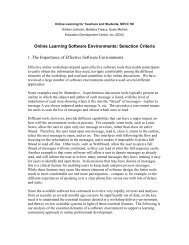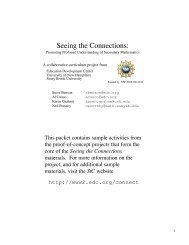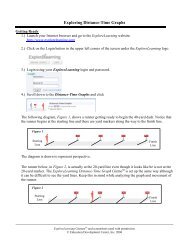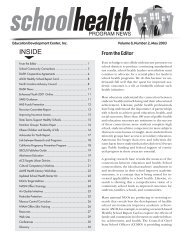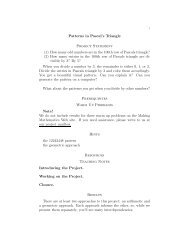It is critical to overcome the digital divide - Education Development ...
It is critical to overcome the digital divide - Education Development ...
It is critical to overcome the digital divide - Education Development ...
You also want an ePaper? Increase the reach of your titles
YUMPU automatically turns print PDFs into web optimized ePapers that Google loves.
Learner Identity, Learning Technologies, and Learner Diversity:A Review of <strong>the</strong> LiteratureCaroline E. Parker, Ed.D.Technology has been heralded as a <strong>critical</strong> learning <strong>to</strong>ol and as a potential source ofequity and increased civic participation for groups and individuals that have not had equal access<strong>to</strong> learning and economic opportunities. Technology provides <strong>the</strong> potential for youth, inparticular, <strong>to</strong> create and <strong>to</strong> participate in civil society in ways that have been unheard of <strong>to</strong> date.At <strong>the</strong> same time, extensive research has shown that patterns of technology use resemble patternsof involvement in science and engineering – women and minorities are less involved in allaspects of technology. Boys are <strong>the</strong> majority users of video games, and men continue <strong>to</strong>dominate <strong>the</strong> field of computer science. In addition, access <strong>to</strong> technology depends onsocioeconomic status, so <strong>the</strong> poorest in both developed and developing countries tend <strong>to</strong> have <strong>the</strong>least access <strong>to</strong> technology. The potential of technology <strong>to</strong> transform lives has been limited byinequities in access. As physical access increases, however, <strong>the</strong> challenges of equity intechnology are not only found in <strong>the</strong> ‘<strong>digital</strong> <strong>divide</strong>’ of access. Even with equal access, womenand minorities are less likely <strong>to</strong> use technology and <strong>to</strong> choose technical careers. Technology hasbeen heralded as ‘neutral,’ but biases in design and values implicit in technology affect differentusers differently. The way technology <strong>to</strong>ols are structured and <strong>the</strong> paradigms of technologydesign and education often d<strong>is</strong>courage women and minorities from using technology orparticipating in <strong>the</strong> process of technology development.Defining technology <strong>is</strong> a monumental task – for th<strong>is</strong> review, we limit ourselves <strong>to</strong>learning technologies. Even settling on a definition of learning technologies can be difficult, and1
th<strong>is</strong> review builds from a hol<strong>is</strong>tic definition (I. Alvarez & Kilbourn, 2002). Our definition oflearning technologies extends beyond a particular piece of software, and encompasses several‘cultural artifacts’ - <strong>the</strong> learning object itself (activity structure, content), <strong>the</strong> user, <strong>the</strong> process foruse (scaffolds, pedagogy), <strong>the</strong> context for use, and <strong>the</strong> (learning) environment in which use takesplace. Learning technologies are a combination of cultural artifacts that are interpreted andexperienced differently depending on individual experiences, identities, and perspectives(Pinkard, 2004).The processes of incorporating learning technologies in<strong>to</strong> <strong>the</strong> learning process are shapedby, and shape, learner identities, learning technology design, and learning media<strong>to</strong>rs, and it <strong>is</strong>with th<strong>is</strong> perspective that we ask such questions as: How do learning technologies shape learneridentities? How do learning media<strong>to</strong>rs (often teachers) contribute <strong>to</strong> <strong>the</strong> learning process? Are<strong>is</strong>sues of access, equity and diversity in technology similar <strong>to</strong> <strong>the</strong>se <strong>is</strong>sues in science,ma<strong>the</strong>matics and engineering? How can different ways of creating and mediating technologybetter engage diverse populations of learners? How do we redesign technology systems andtechnologies <strong>the</strong>mselves <strong>to</strong> make <strong>the</strong>m more effective with and inclusive of diverse learners?Answering <strong>the</strong>se questions demands multid<strong>is</strong>ciplinary strands of inquiry that address several<strong>the</strong>mes: classroom based technologies, <strong>digital</strong> learning in informal settings, <strong>the</strong> development ofcommunity and power dynamics within <strong>digital</strong> learning environments, and <strong>the</strong> development ofcomputer science and its influence on supporting diverse learners.Th<strong>is</strong> literature review focuses on <strong>the</strong> gap between current patterns of technology designand use and technology’s potential <strong>to</strong> be a <strong>to</strong>ol <strong>to</strong> promote individual and communitydevelopment. We begin by looking at <strong>the</strong> <strong>digital</strong> <strong>divide</strong>, <strong>to</strong> provide a background understandingof h<strong>is</strong><strong>to</strong>rical <strong>is</strong>sues of access and participation in both technology and <strong>the</strong> sciences. We <strong>the</strong>n2
consider <strong>the</strong> overlapping areas of culture and technology, and education and technology. Thesection on culture considers how learner identities and cultural background contribute <strong>to</strong>technology use and learning. The section on education looks specifically at <strong>the</strong> ways thattechnology has, or has not, been used effectively in formal and informal education. The reviewconcludes with questions for fur<strong>the</strong>r research.Throughout <strong>the</strong> review we include excerpts from an online dialog conducted by <strong>the</strong>Gender, Diversities & Technology Institute in 2004 on <strong>the</strong> subject of ‘Facilitating and SustainingDiverse Online Communities.’- The Institute assembled an international panel of experts <strong>to</strong>explore such questions as: What are <strong>the</strong> requirements for creating, growing and sustainingdiverse online communities? Do current technologies support and enhance online learningequitably across all learner diversities, including race, SES, d<strong>is</strong>ability and gender? How doex<strong>is</strong>ting learning technologies reflect and reproduce current societal and cultural biases?THE DIGITAL DIVIDE: ACCESS, PARTICIPATION, RECRUITMENT, RETENTIONThe <strong>digital</strong> <strong>divide</strong> has generally been defined as <strong>the</strong> gap in access <strong>to</strong> technology bysocioeconomic status, race, and/or gender. The technologies most often used in studies of <strong>the</strong><strong>digital</strong> <strong>divide</strong> are personal computers and Internet access/connectivity. Efforts <strong>to</strong> <strong>overcome</strong> <strong>the</strong><strong>digital</strong> <strong>divide</strong> include increasing technology access in schools (Kane, Beals, Valeau, & Johnson,2004) and development of community technology centers (Schon, Sanyal, & Mitchell, 1998).These programs provide <strong>the</strong> technology <strong>to</strong> populations who may not have <strong>the</strong> economicresources <strong>to</strong> acquire <strong>the</strong> technology for <strong>the</strong>mselves. Home use of computers continues <strong>to</strong> show agap by race, but that gap <strong>is</strong> closed substantially when community technology access <strong>is</strong> included(A. Alvarez, 2003). Internet use has an even wider gap between whites and minorities, with29.3% of African Americans and 23.7% of Latinos using <strong>the</strong> Internet, as compared with 50.3%3
of non-Latino whites (Fairlie, 2002). In a study of youth computer use, Eamon found that pooryouth are much less likely <strong>to</strong> have a computer in <strong>the</strong>ir home (Eamon, 2004). Foster children areano<strong>the</strong>r group that has less access <strong>to</strong> computers (Finn, Kerman, & LeCornec, 2004). Women andminorities continue <strong>to</strong> be underrepresented in <strong>the</strong> sciences, especially computer science (Camp,“<strong>It</strong> seems <strong>to</strong> me...that <strong>the</strong> gender problem has more <strong>to</strong> do with <strong>the</strong> lack of instruction andinvolvement. Aunts, s<strong>is</strong>ters, mo<strong>the</strong>rs, grandmo<strong>the</strong>rs and teachers (many being female) areoften instructed in technology by people with <strong>the</strong> machines in mind and not <strong>the</strong> learningprocess…In general a female point of view, or a learners point of view that may be outside ofa tech v<strong>is</strong>ion might be ignored. Many instruc<strong>to</strong>rs have <strong>the</strong> machine in mind, not <strong>the</strong> outcomeand <strong>the</strong> possibilities.”Bonnie Bracey, <strong>Education</strong>al Consultant1997; Clewell & Campbell, 2002), although all science and engineering fields except computerscience are increasing <strong>the</strong>ir proportion of women graduates (Losh, 2003).In <strong>the</strong> field of science and ma<strong>the</strong>matics, a number of steps have been taken <strong>to</strong> addressinequities. The lack of women and minorities in <strong>the</strong> sciences can be partially attributed <strong>to</strong> a lackof preparation. When students do not have access <strong>to</strong> advanced math courses or <strong>to</strong> quality sciencecurriculum, <strong>the</strong>y are not qualified <strong>to</strong> pursue science and ma<strong>the</strong>matics careers. Currently, <strong>the</strong> <strong>is</strong>sueof gender differs from that of race. Over <strong>the</strong> last twenty years, girls, on average, have increased<strong>the</strong>ir attendance in, and success at, high school ma<strong>the</strong>matics and science courses (Clewell &Campbell, 2002). However, when <strong>the</strong>y reach <strong>the</strong> level of higher education, girls still do notchoose science careers. In contrast, minorities have inadequate access <strong>to</strong> science andma<strong>the</strong>matics courses at <strong>the</strong> high school level, and so while <strong>the</strong>y would choose science careers ifpossible, <strong>the</strong>y are not able <strong>to</strong> do so (Clewell & Campbell, 2002).4
life <strong>the</strong>y offer <strong>to</strong> women and minorities. O<strong>the</strong>rs argue that <strong>the</strong> online world <strong>is</strong> reproducing <strong>the</strong>same inequalities as <strong>the</strong> offline world, and losing an opportunity for social change (Cook, 2004).“…A growing body of research <strong>is</strong> producing evidence that traditional off-linehierarchies and biases pers<strong>is</strong>t in CMC [computer mediated communications]. My own work,for example, has shown that males tend <strong>to</strong> dominate in mixed-sex computer-mediatedinteractions, including in academic d<strong>is</strong>cussion forums, through amount of talk, control of<strong>to</strong>pics of d<strong>is</strong>cussion, claims <strong>to</strong> authority, and adversarial behavior such as challenges andput-downs. Such behaviors may cause females <strong>to</strong> limit <strong>the</strong>ir participation, fall silent, orwithdraw from <strong>the</strong> forum al<strong>to</strong>ge<strong>the</strong>r, with concomitant loss of access <strong>to</strong> <strong>the</strong> opportunitiesprovided through <strong>the</strong> online environment.”Susan Herring, Professor of Information Science, Adjunct Professor of Lingu<strong>is</strong>tics,Indiana UniversityLight (2001), in “Rethinking <strong>the</strong> Digital Divide” argues that o<strong>the</strong>r structural inequitiescan’t be ignored, and that those concerned with inequities in <strong>the</strong> field of technology use have <strong>to</strong>also address institutional bias and how society <strong>is</strong> organized (Light, 2001). Schofield andDavidson (2001 - cite) looked at how access <strong>to</strong> technology was used as a form of reward inschools, and thus those who tend <strong>to</strong> get pun<strong>is</strong>hed <strong>the</strong> most, Black and Latino boys (Noguera,2003), were <strong>the</strong> least likely <strong>to</strong> have access <strong>to</strong> technology (Schofield & Davidson, 2001).“Researchers must look more closely at how schools, as social institutions embedded within alarger structure of inequality, are complicit in technological d<strong>is</strong>parities” (Brown-L’Bahy, 2003,p. 16).CULTURE, IDENTITY, AND TECHNOLOGYYouth identity development: a frameworkThe field of youth identity development includes different <strong>the</strong>ories and explanations for<strong>the</strong> way that youth develop <strong>the</strong>ir identities. How youth see <strong>the</strong>mselves as learners, andconsequently as active agents in <strong>the</strong>ir future well-being, has moved from reproduction <strong>the</strong>ories6
(Bowles & Gint<strong>is</strong>, 1976), arguing that schools reproduce society’s structures and youth arehelpless <strong>to</strong> change that, <strong>to</strong> res<strong>is</strong>tance <strong>the</strong>ories (Giroux, 1983; Macleod, 1995; Mehan, Villanueva,Hubbard, & Lintz, 1996; Will<strong>is</strong>, 1977) that identify ways that individuals res<strong>is</strong>t <strong>the</strong> structuresimposed on <strong>the</strong>m. Youth develop <strong>the</strong>ir identities in interaction with <strong>the</strong> structures <strong>the</strong>y face and<strong>the</strong> cultures <strong>the</strong>y are part of (Davidson, 1996; Holland, Lachicotte Jr., Skinner, & Cain, 1998).Within th<strong>is</strong> framework of agency/culture/structure, learning technologies can be a part ofagency, culture, or structure. When <strong>the</strong> technologies are foreign <strong>to</strong> youth, when <strong>the</strong>y are anoutside force <strong>to</strong> be reckoned with, <strong>the</strong>y are structures that youth confront with <strong>the</strong>ir agency.When technologies are more integrated in<strong>to</strong> youth identities, <strong>the</strong>y are part of youth culture.Youth interact with technology based on <strong>the</strong>ir identity, and technology can shape youthidentities. Thus, it <strong>is</strong> very important <strong>to</strong> understand how youth conceptualize <strong>the</strong>ir learningtechnologies – if <strong>the</strong> technologies are foreign <strong>to</strong> <strong>the</strong>m, <strong>the</strong>y become part of <strong>the</strong> structures thatyouth face daily. If technologies are an integral part of <strong>the</strong>ir lives, <strong>the</strong>n <strong>the</strong>y are part of <strong>the</strong> youthculture, and <strong>the</strong>y both contribute <strong>to</strong> youth identities, and are interpreted differently based ondifferent youth identities.There <strong>is</strong> also research <strong>to</strong> support that youth use <strong>the</strong>ir prior cultural knowledge <strong>to</strong>understand and use <strong>the</strong> <strong>to</strong>ols that mediate <strong>the</strong>ir interactions with <strong>the</strong> world (Vygotsky, 1978).“The more <strong>the</strong> mediating <strong>to</strong>ol draws from <strong>the</strong> prior cultural knowledge of users, <strong>the</strong>more likely <strong>the</strong>y are <strong>to</strong> be able <strong>to</strong> use <strong>the</strong> <strong>to</strong>ol for its intended purpose. Given growingclassroom diversity and <strong>the</strong> continued silence regarding culture and design, it <strong>is</strong> highlypossible that learning <strong>to</strong>ols perceived as 'designed for all' by <strong>the</strong> design team are perceived as'designed for some' by students’.”Nichole Pinkard, Research Associate and Direc<strong>to</strong>r of <strong>Education</strong>al Technology, Centerfor School Improvement, University of Chicago7
Giese studied identity formation in one online environment and argues that computermediatedcommunication produces both a new social environment and new opportunities forpresentation of <strong>the</strong> self (Giese, 1998). Online communities are <strong>the</strong> source of study as a way ofunderstanding <strong>the</strong> development of social identity (Cassell & Tversky, 2005). Youth think of<strong>the</strong>mselves differently when <strong>the</strong>y can interact with technology, use it for communication, andchoose <strong>the</strong>ir own entertainment (Tapscott, 1998). Turkle suggests that <strong>the</strong> fluidity of identitymeans that computers can be part of an extended “cyber self” (Sherry Turkle, 2003). O<strong>the</strong>rsargue that while technology has changed some things, fundamental identity development remains<strong>the</strong> same (Katz, 1997).Th<strong>is</strong> review argues that identity develops interactively, in relation <strong>to</strong> o<strong>the</strong>rs, <strong>to</strong> culture,and <strong>to</strong> outside structures. What does it mean if some youth see technology as an integral part of<strong>the</strong>ir identity, or as an effective <strong>to</strong>ol for communication and work, while o<strong>the</strong>rs see it as a foreignstructure? How do <strong>the</strong> identities of youth who are empowered by technology differ from thosewho are d<strong>is</strong>empowered by that technology?“I have observed my 14-year-old nephew, both f2f and online, in [<strong>the</strong> game]Runescape. <strong>It</strong> <strong>is</strong> amazing <strong>to</strong> me <strong>the</strong> complexity that th<strong>is</strong> child <strong>is</strong> dealing with. Far beyondanything he <strong>is</strong> offered in school. He (and anyone else who pers<strong>is</strong>ts in <strong>the</strong> game over time) <strong>is</strong>oddly motivated <strong>to</strong> practice numerous skills <strong>to</strong> achieve ‘au<strong>to</strong>maticity’ as well as recognizedachievement levels through what seems <strong>to</strong> me tedious repetition; learn and apply a greatmany new concepts and terminology; apply at any given time a multiplicity of dimensions andparameters for complex dec<strong>is</strong>ion-making; and dev<strong>is</strong>e creative strategies involving bothcompetition and collaboration with o<strong>the</strong>rs in real time.”Beverly Hunter, Dialog ParticipantCulture and technologyEven when given access <strong>to</strong> technology, minority communities use <strong>the</strong> Internet less(Stanley, 2003). In a study of poor women who were given home computers and Internet access8
for a year, women of color reported lower use, even when controlling for socioeconomic status(Jackson, Barbats<strong>is</strong>, Biocca, Zhao, & Fitzgerald, 2003). The authors conclude that culturalfac<strong>to</strong>rs play a key role in technology use, and need <strong>to</strong> be addressed in future research. In contrast,a study of black and white Internet use found more similarities than differences between <strong>the</strong> twogroups, though “whites focus more on news, financial, and political Websites, whereas Blacksare drawn <strong>to</strong> education-related sites” (A. Alvarez, 2003). A study of d<strong>is</strong>tance education linkingan urban classroom with a university music classroom via videoconferencing found that teachersimposed standards of behavior on <strong>the</strong> students and that cultural gaps between <strong>the</strong> two physicalworlds were not bridged via <strong>the</strong> videoconferencing (Knight, Dixon, Nor<strong>to</strong>n, & Bentley, 2004).The videoconference reinforced <strong>the</strong> cultural differences between <strong>the</strong> student participants and <strong>the</strong>music school. These individual studies indicate that <strong>the</strong>re are cultural differences in computerand Internet use, which <strong>is</strong> not particularly surpr<strong>is</strong>ing. A study of four community technologycenters looking at adults using computers for <strong>the</strong> first time (Stanley, 2003), identified threeimportant ways <strong>to</strong> look at technology in order <strong>to</strong> understand technology use among those who donot use it. First, Stanley describes <strong>the</strong> relevance of technology: that <strong>is</strong>, if users don’t see a link <strong>to</strong><strong>the</strong>ir own life, <strong>the</strong>y won’t use it. Second, he looks at comfort zones, encompassing perceptions ofhigh cost or difficulty of use. Third, he addresses self-concepts; how individuals see <strong>the</strong>mselvesin relation <strong>to</strong> technology. People who don’t think of <strong>the</strong>mselves as <strong>the</strong> type of person who uses acomputer will not choose <strong>to</strong> use technology.While differences in computer use between men and women are small, women whoexpress interest in computers do not also express interest in computer-related careers, whereasmen do (Creamer, Burger, & Meszaros, 2004), indicating that access <strong>is</strong> less of an <strong>is</strong>sue thanchoice, for women. A study of women in technology classrooms described low self-confidence9
and a sense that boys act like <strong>the</strong>y know more (Gokhale & Stier, 2004). Clewell and Burger(2002) argue that “future efforts must include interventions <strong>to</strong> change <strong>the</strong> system of science andengineering so that it becomes more accepting of women (and o<strong>the</strong>r underrepresented groups)”(Clewell & Burger, 2002) p.252. Brown-L’Bahy posits, “Girls who appear <strong>to</strong> res<strong>is</strong>t computer usemay be res<strong>is</strong>ting content matter or particular purposes or types of computer use” (Brunner,Bennett, & Honey, 2000; S Turkle, 1997 in Brown-L'Bahy, 2003, p.14).“The question [boils] down <strong>to</strong> at what level are people <strong>the</strong> same, and at what level are<strong>the</strong>y different from one ano<strong>the</strong>r. Th<strong>is</strong> <strong>is</strong> a good and important realization paralleled in <strong>the</strong>field of anthropology. Notions of culture often imply that a particular group of people,whe<strong>the</strong>r <strong>the</strong>y are a racial/ethnic group, or a gender group, or a socio-economic group, are all<strong>the</strong> same and <strong>the</strong>re <strong>is</strong> no internal group diversity. Th<strong>is</strong> tendency <strong>to</strong> see culture ashomogeneous has led <strong>to</strong> group stereotyping and a failure <strong>to</strong> understand <strong>the</strong> complexity ofdiversity.”Wesley Shumar, Ass<strong>is</strong>tant Professor of Culture & Communication, Drexel UniversityValues and technologyZuga claims that women have a “different way of knowing” than men, and <strong>the</strong> field oftechnology (and science) needs <strong>to</strong> incorporate those different ways of knowing (Zuga, 1999).She argues that technology <strong>is</strong> not a value-free science, and it must address ethical <strong>is</strong>sues, such asenvironmental<strong>is</strong>m, in order <strong>to</strong> appeal <strong>to</strong> women.More technology educa<strong>to</strong>rs could begin <strong>to</strong> address <strong>the</strong> subject of technologyeducation with a <strong>critical</strong> view focusing on <strong>the</strong> role of technology as a system andas practice in which <strong>the</strong>re are choices about our future course of action…Implementing a social reconstruction curriculum design in technology educationencourages thoughtful critique of <strong>the</strong> status quo and ex<strong>is</strong>ting practice with respect<strong>to</strong> technology (Zuga, 1999).10
She continues, “addressing <strong>the</strong> critiques of technology would benefit all students byhelping <strong>the</strong>m <strong>to</strong> understand that technology <strong>is</strong> a debatable practice with both positive andnegative consequences for <strong>the</strong> environment and different groups of people” (Zuga, 1999).Ebo points out that technology has been used <strong>to</strong> glorify war, particularly during <strong>the</strong> firstGulf War (Ebo, 1995). In addition <strong>to</strong> addressing <strong>the</strong> values and ethics of technology,o<strong>the</strong>rs argue that emotions play a role in learning, and that th<strong>is</strong> must be addressed in <strong>the</strong>field of technology (Kort & Reilly, 2002).The field of values in technology use has been greatly understudied. While Zuga’sargument that women are inherently more ethical than men can be debated, her point <strong>is</strong>well taken that by portraying technology as value-free, those who d<strong>is</strong>agree are less likely<strong>to</strong> involve <strong>the</strong>mselves in technology-related activities. Similar findings showed that girls,ra<strong>the</strong>r than being computer-phobic, are <strong>critical</strong> of <strong>the</strong> content of computer technologies,particularly gaming (Wartella, O'Keefe, & Scantlin, 2000). Whe<strong>the</strong>r or not womeninnately look for <strong>the</strong> ethical value in technology while men do not, <strong>the</strong> need <strong>to</strong> address<strong>the</strong> <strong>is</strong>sue <strong>is</strong> a valid one. What are <strong>the</strong> ‘ethics messages’ communicated by technology?How do different individuals and groups variously interpret <strong>the</strong>se? Where are <strong>the</strong> ‘spaces’in technology for addressing <strong>the</strong>se <strong>is</strong>sues? How do youth make sense of <strong>the</strong> ethical <strong>is</strong>suessurrounding technology use?TECHNOLOGY AND EDUCATION: OIL AND WATER?Across <strong>the</strong> United States, public schools have been increasingly outfitted with technologyhardware and wiring: computers, Internet access, PDAs, etc. Despite all of <strong>the</strong> investment,technology <strong>is</strong> rarely used effectively in school settings. Studies have shown some of <strong>the</strong> waysthat technology in education <strong>is</strong> not working. Urban schools that have similar levels of investment11
in technology similar <strong>to</strong> suburban schools continue <strong>to</strong> underutilize it, more often having studentsuse computers for skills development through drills, whereas <strong>the</strong>ir suburban counterparts areusing technology <strong>to</strong> acquire information or develop products (Shreve, 2005). In o<strong>the</strong>r cases,youth are using technology outside of <strong>the</strong> school setting in ways that far exceed <strong>the</strong> tasksteachers set for <strong>the</strong>m, and <strong>the</strong> technology <strong>is</strong> underutilized in <strong>the</strong> learning context (Cuban, 2001a;Green & Bavelier, 2003; Papert, 1998a). In a review of technology, literacy and inequity,Brown-L’Bahy describes five assumptions about technology that influence <strong>the</strong> field of learningtechnologies: 1)<strong>the</strong> inherent goodness of technology; 2) <strong>the</strong> economic primacy of technologyuse; 3) intrinsically valenced forms of technology use; 4) neutrality of technology; 5)au<strong>to</strong>nomous realms of technology; 6) and individual<strong>is</strong>m (Brown-L’Bahy, 2003, p. 19). She notesthat <strong>the</strong>re <strong>is</strong> little or no research drawing a causal relationship between increased technology useand economic wellbeing (p. 25), and continues, “stat<strong>is</strong>tics also show that rapid growth incomputer use among low income people and minorities over <strong>the</strong> last five years has nei<strong>the</strong>rresulted in significant changes in employment and poverty rates, nor has it erased patterns oftechnological d<strong>is</strong>parity based on race and class” (Brown-L’Bahy, 2003, p. 26, from Bureau ofLabor Stat<strong>is</strong>tics 2002, US Census Bureau 2002). She challenges learning technology researchersby noting that both teachers and students often “res<strong>is</strong>t adopting recommended forms oftechnological use.” Do teachers res<strong>is</strong>t <strong>the</strong> technologies because <strong>the</strong>y are unwilling <strong>to</strong> makepositive changes? Or are learning technology advocates pushing a form of technology that <strong>is</strong> notrelevant and, as Brown-L’Bahy has shown, does not have a research base <strong>to</strong> show its superiority<strong>to</strong> out-of-school technology use? In addition, learning technolog<strong>is</strong>ts devalue students’ out-ofschooluses of technology. Brown-L’Bahy argues that by pushing technology on res<strong>is</strong>tantteachers, and devaluing out-of-school youth technology use, valuable opportunities may be lost.12
Attempts <strong>to</strong> address <strong>the</strong>se and o<strong>the</strong>r challenges facing learning technologies are describedhere in four areas: technology programs that target specific groups of youth, software that targetsspecific groups of youth, learning media<strong>to</strong>rs (teachers), and calls for <strong>the</strong> wholesaletransformation of formal education <strong>to</strong> reflect <strong>the</strong> sea change in knowledge and learning thattechnology advances bring.“In terms of educational <strong>to</strong>ols <strong>the</strong>re <strong>is</strong>n't a powerful market force necessitating that wedesign for diversity. There <strong>is</strong>n't a school d<strong>is</strong>trict or university refusing <strong>to</strong> purchase productsbecause <strong>the</strong>y don't meet <strong>the</strong> needs of <strong>the</strong> diversity of learners that d<strong>is</strong>trict or universityserves.”Nichole Pinkard, Research Associate and Direc<strong>to</strong>r of <strong>Education</strong>al Technology, Centerfor School Improvement, University of ChicagoTargeted technology programsIn <strong>the</strong> field of education and technology, <strong>the</strong>re have been many different interventionsthat target specific populations. Some focus on encouraging girls <strong>to</strong> pursue careers in science andtechnology (Spears, Dyer, Franks, & Montelone, 2004). One intervention that proposed <strong>to</strong>encourage girls’ participation in STEM careers found that <strong>the</strong> strongest effect was on <strong>the</strong> womentu<strong>to</strong>rs, who found <strong>the</strong>ir own interest and confidence in STEM careers increased more than didthat of <strong>the</strong> target girls (Crowe, 2003). By <strong>the</strong> same <strong>to</strong>ken, <strong>the</strong>re <strong>is</strong> also research <strong>to</strong> suggest thattargeted interventions for specific populations have positive effects across <strong>the</strong> board. What workswell for girls also works for boys, but not necessarily vice versa (Congressional Comm<strong>is</strong>sion,2000; McCullough, 2001, Tech-Savvy, 2000). Some researchers present ways that technologycan contribute <strong>to</strong> curricula that ‘create liminal spaces for <strong>the</strong> negotiation of identity andknowledge’ (Voithofer, 2002) and that are inclusive (Ibarra, 2000; McLoughline & Oliver, 2000;13
Yong & Parrella, 2004), while o<strong>the</strong>rs have found that online courses can be d<strong>is</strong>engaging forteachers (Gabbard, Perez, & Atkins, 2002).An extensive review of research focusing on <strong>the</strong> impact of interactive media on children(not focusing exclusively on schools), looked at access, impact on cognitive development, socialdevelopment, and health and safety (Wartella et al., 2000). <strong>It</strong> found that boys use computergames more than girls, and that, as noted above girls are not computer-phobic but are <strong>critical</strong> ofcomputer content (p. 7). The study also looks at <strong>the</strong> interaction between content, activities,conditions, and goals. Wartella et. al. argue that <strong>the</strong> content of <strong>the</strong> technology <strong>is</strong> more importantthan <strong>the</strong> process, counter <strong>to</strong> o<strong>the</strong>r researchers, who argue that <strong>the</strong> process of engaging withtechnology, regardless of content, changes <strong>the</strong> learning process (J. P. Gee, 2003; Papert, 1998b).Some researchers identify <strong>the</strong> character<strong>is</strong>tics of technology that contribute <strong>to</strong> learning, includinglearning through active engagement, participation in groups, frequent interaction and feedback,connections <strong>to</strong> real-world contexts, and expanding what children learn (Roschelle, Pea, Hoadley,Gordin, & Means, 2000). All of <strong>the</strong>se highlight <strong>the</strong> importance of technological processes on“Exposing students <strong>to</strong> different styles of learning beyond F2F instruction can not onlyincrease, but also help <strong>the</strong>m feel better about <strong>the</strong>ir ability <strong>to</strong> learn. Therefore, in order <strong>to</strong>ensure equity, we need <strong>to</strong> design learning experiences that are inclusive and respectful ofgender, culture, and race.”Chr<strong>is</strong> Dede, Professor of Learning Technologies, Harvard Graduate School of <strong>Education</strong>learning, arguing that technology <strong>is</strong> more than just a different form of ‘shell’ for providingcontent.Wartella et al. found no research documenting <strong>the</strong> effects on academic achievement ofplaying computer games, though games and technology are increasingly seen <strong>to</strong> have a <strong>critical</strong>role in education (Oblinger, 2004). Researchers look at how technology can bring ‘serious play’in<strong>to</strong> formal learning (Rieber, Smith, & Noah, 1998). Youth will spontaneously spend more than14
100 hours playing complex video games that demand extensive cognitive development, butformal schooling has been unable <strong>to</strong> harness <strong>the</strong> principles of learning in video games that are sosuccessful (J. P. Gee, 2003). To date, “edutainment” has been a weak effort <strong>to</strong> link vibranttechnologies with formal education. Learning technologies have received <strong>the</strong>ir share of critic<strong>is</strong>m(J. Gee, 2003). Gee argues that gaming <strong>is</strong> an environment far more conducive <strong>to</strong> learning, andthat when educa<strong>to</strong>rs attempt <strong>to</strong> copy gaming strategies in<strong>to</strong> <strong>the</strong>ir learning technologies, <strong>the</strong>y areweak imitations.Content of learning technologiesCan modifying <strong>the</strong> content of learning technologies improve access <strong>to</strong> and interestin those technologies? Two studies argue in favor of th<strong>is</strong> (Laffey, Espinosa, Moore, &Lodree, 2003; Pinkard, 1999). Laffey used interactive computer programs as part of aprogram <strong>to</strong> address behavior <strong>is</strong>sues among at-r<strong>is</strong>k African-American kindergarten andfirst grade students, and found that math engagement and attainment improved when lossof computer time was no longer used as a pun<strong>is</strong>hment (Laffey et al., 2003). Pinkarddeveloped two ‘culturally responsive’ reading software packages that incorporate rappingand clapping in<strong>to</strong> early reading, and found, again, that interest and attainment improved(Pinkard, 1999).Pinkard found that students as young as seven years old identify software asgendered. Even in supposedly gender-neutral online chat rooms, studies have shown thatmen continue <strong>to</strong> dominate and use aggressive tactics <strong>to</strong> silence women, challenging <strong>the</strong>irability <strong>to</strong> be present and active in virtual public spaces (Herring, 1999).Shreve describes <strong>the</strong> way that stimulating computer games can motivate students<strong>to</strong> learn academic material (Shreve, 2005). Online video games demand analytical15
thinking, take a long time <strong>to</strong> complete, and allow students <strong>to</strong> engage actively in variedenvironments. When <strong>the</strong>se elements are included in ‘educational’ learning games, if donecorrectly, <strong>the</strong>n <strong>the</strong> computer games can also be learning experiences for school-basedlearning. However, th<strong>is</strong> ra<strong>is</strong>es two <strong>is</strong>sues: <strong>to</strong> what degree <strong>is</strong> out-of-school technology“We are interested in how multi-user environments (MUVEs) can be used in K-12 settings <strong>to</strong>foster learning. Multi-user virtual environments enable multiple simultaneous participants <strong>to</strong>access virtual contexts, <strong>to</strong> interact with <strong>digital</strong> artifacts, <strong>to</strong> represent <strong>the</strong>mselves throughavatars, <strong>to</strong> communicate with o<strong>the</strong>r participants and with computer-based agents, and <strong>to</strong>enact collaborative learning activities of various types. We designed a MUVE entitled, RiverCity, that teaches science inquiry and process skills <strong>to</strong> middle school students. Our design <strong>is</strong>geared <strong>to</strong>wards students in urban schools with lower SES who might not be engaged bytraditional F2F instruction. In our first pilot…we found <strong>the</strong> multi-user environment wedesigned was motivating for lower SES students and for students of H<strong>is</strong>panic descent.H<strong>is</strong>panic students with low GPA and low SES improved <strong>the</strong>ir content score by approximately20 points across <strong>the</strong> board.”Chr<strong>is</strong> Dede, Professor of Learning Technologies, Harvard Graduate School of <strong>Education</strong>already helping youth develop <strong>the</strong> skills that schools try <strong>to</strong> give <strong>the</strong>m; and, why <strong>is</strong> it sodifficult <strong>to</strong> have formal learning technologies capture youth’s interest in <strong>the</strong> same way asnon-school computer games?Media<strong>to</strong>rs of learning technologiesBarbara Means env<strong>is</strong>ions a classroom where teachers mediate online learning for students(Means, 2000). A qualitative study of low-and high SES schools, however, found that teachers atboth schools tend <strong>to</strong> teach technology as an end in itself (requiring that students master allaspects of PowerPoint ra<strong>the</strong>r than learn how PowerPoint can be an effective/ineffectivecommunication <strong>to</strong>ol) ra<strong>the</strong>r than using it <strong>to</strong> increase <strong>the</strong> potential of student learning(Warschauer et al., 2004). Teachers tend <strong>to</strong> integrate technology less with low achievers(Dividing Lines, 2001). In order <strong>to</strong> integrate technology effectively, teachers must learn <strong>to</strong> see<strong>the</strong>mselves as media<strong>to</strong>rs and let go of <strong>the</strong> expectation that <strong>the</strong>y will be <strong>the</strong> expert (Dede, 2004).16
In a study of teacher use of technology in <strong>the</strong> classroom known as Effective Access, many of <strong>the</strong>challenges facing teachers were identified:- teachers see <strong>the</strong> benefit from <strong>digital</strong> resources but don’t know how <strong>to</strong> access <strong>the</strong>m;- teachers have minimal time;- technology infrastructures are often insufficient;- teacher skills are not adequate;- teachers tend <strong>to</strong> use <strong>the</strong> web for content only;- teachers identify a lack of quality professional development.The study shows that most teachers’ experiences are still a long way from Means’ v<strong>is</strong>ionof teachers mediating online learning for students (Hanson & Carlson, 2005).Transforming educationIncreasingly, technology educa<strong>to</strong>rs are advocating a full transformation ofeducation, arguing that technology has <strong>the</strong> potential <strong>to</strong> incorporate more styles of learningthan traditional educational models (Guild, 2001; Lemke, 2002; Spender, 1998; SherryTurkle, 2003). Some argue that education should not limit itself <strong>to</strong> traditional conceptionsof talent, but should see <strong>the</strong> potential for developing talent in rich environments (Barab &Plucker, 2002). Natriello notes that sociolog<strong>is</strong>ts of education have an obligation <strong>to</strong>address <strong>the</strong> many changes in education that technology will bring in order <strong>to</strong> make surethat all students have access <strong>to</strong> all aspects of technology, not just <strong>the</strong> physicalaccoutrements (Natriello, 2001). In a Vygotskian framework, learning technologies arescaffolds for learning, and imply a transformation of formal learning (McLoughline &Oliver, 2000; Somekh & Mavers, 2003; Voithofer, 2002), including teachers as colearnersand students working more au<strong>to</strong>nomously. An open classroom, and access <strong>to</strong> a17
variety of technologies, allowed incarcerated youth <strong>to</strong> engage with learning in ways <strong>the</strong>yhad not previously (Cavallo, Papert, & Stager, 2004). However, as long as assessmentscontinue <strong>to</strong> measure knowledge without taking in<strong>to</strong> account <strong>the</strong> mega-changes in learningthat ICT entails, <strong>the</strong> positive changes will not be measured (Somekh & Mavers, 2003).Roschelle et al. outline four areas for change: technology should use what <strong>is</strong> known aboutcognitive learning, technology should link <strong>to</strong> curricular reforms that provide access <strong>to</strong>more learning, <strong>the</strong>re should be coordinated interventions, and <strong>the</strong>re needs <strong>to</strong> be a“As technology evolves or emerges <strong>the</strong>re <strong>is</strong> a learning curve unlike anything we have everencountered in education. Books are, or were introduced slowly, and were a guide <strong>to</strong> a staticamount of information. Things have changed. The access <strong>to</strong> information has changed. Thepaths <strong>to</strong> learning have increased. The possibilities for individualization of learning haveincreased.”Bonnie Bracey, <strong>Education</strong>al Consultantrecognition that not all schools have <strong>the</strong> capacity <strong>to</strong> be transformed at <strong>the</strong> same time(Roschelle et al., 2000).Papert argues that technology will change education through an evolutionary system(Papert, 1997). He does not expect large-scale reforms <strong>to</strong> incorporate <strong>the</strong> ways technology <strong>is</strong>already changing <strong>the</strong> experiences of youth, but ra<strong>the</strong>r argues that it will happen in a decentralizedmanner. Tapscott also argues that education has huge potential for transformation if it will buildon youth experiences with technology (Tapscott, 1998). Cuban agrees that technology will nothave a positive effect on schools, but he argues that th<strong>is</strong> <strong>is</strong> because schools are <strong>to</strong>o res<strong>is</strong>tant <strong>to</strong>change (Cuban, 2001a, 2001b; Wartella et al., 2000). He argues that <strong>the</strong> money spent <strong>to</strong>‘connect’ all US schools has been a poor investment, and that teachers do not take advantage ofall that technology has <strong>to</strong> offer. Atkinson et al. (2001), in a meta analys<strong>is</strong> of research looking at18
<strong>the</strong> effects of technology on children’s learning, found that technology did have a positive effec<strong>to</strong>n children’s learning (Atkinson et al., 2001).While technology <strong>is</strong> often associated with science and math, a growing body of literature<strong>is</strong> examining <strong>the</strong> way that literacy <strong>is</strong> shifting as a result of technology. Both <strong>the</strong> expansion ofinformation via <strong>the</strong> Internet, and shifts in youth literacies based on new technologies (forexample, instant messaging), need <strong>to</strong> be incorporated in<strong>to</strong> formal education (Alvermann, 2004;Tully, 2003; Williamson & Facer, 2004). Just as youth engage in technology outside of school,so do <strong>the</strong>y have a whole series of literacy practices that do not fit well in<strong>to</strong> <strong>the</strong> confinement offormal schooling (Luttrell & Parker, 2001). Some of <strong>the</strong>se changes are taking place already, but<strong>to</strong>o often <strong>the</strong> shifts in pedagogy are used only with privileged youth. Students of different socialclasses describe different ways of viewing <strong>the</strong>mselves, <strong>the</strong> value of <strong>the</strong>ir out-of-school literacies,and <strong>the</strong>ir future roles (Gee, 2000; Luttrell & Parker, 2001).Who does <strong>the</strong> designing?Who designs technology? Druin argues that children should be actively involved in <strong>the</strong>design of learning technologies (Druin, 2002), and has implemented projects that do just that.Cultural <strong>is</strong>sues in technology design are rarely addressed, both who designs <strong>the</strong> technology, andwhich audiences are left out of <strong>the</strong> design process.“The consequences of a lack of awareness by researchers and designers of <strong>the</strong>ir culturalassumptions and <strong>the</strong> framework for how culture can influence design can result in a culturald<strong>is</strong>connect between designers of learning <strong>to</strong>ols and <strong>the</strong>ir intended audience, which leads <strong>to</strong>unachieved learning goals and lack of student engagement.”Nichole Pinkard, Research Associate and Direc<strong>to</strong>r of <strong>Education</strong>al Technology, Centerfor School Improvement, University of Chicago19
While some argue that technology shows its bias only in <strong>the</strong> content, th<strong>is</strong> review arguesthat <strong>the</strong> way technology <strong>is</strong> designed can also show bias. There <strong>is</strong> a language of power intechnology terms like webmaster, mo<strong>the</strong>r board, master server (Brown-L’Bahy, 2003).Technology <strong>is</strong> designed, for <strong>the</strong> most part, by white men, and while some try <strong>to</strong> argue that <strong>the</strong>technology <strong>is</strong> neutral, o<strong>the</strong>rs point out its biases (Ebo, 1995; Zuga, 1999). There <strong>is</strong> an interactionbetween “designers’ creation of virtual environments” and “users’ construction of identity”(McDonough, 1999, p.856). McDonough continues, “technological development involves aprocess in which <strong>the</strong> technological artifacts which designers create embody <strong>the</strong> designers’understandings of <strong>the</strong> potential uses of <strong>the</strong>ir product” (McDonough, p. 857). A clear example ofth<strong>is</strong> <strong>is</strong> <strong>the</strong> design of “avatars,” figures that individuals choose <strong>to</strong> represent <strong>the</strong>mselves in virtualspace. “By d<strong>is</strong>proportionately drawing upon certain cultural sources for worlds’ <strong>the</strong>mes,designers are closely bound with particular groups within <strong>the</strong> culture of <strong>the</strong> US” (p.862).“Because designers can make many different dec<strong>is</strong>ions that have cultural implications <strong>the</strong>n Iwould argue that it <strong>is</strong> not that <strong>the</strong> technology itself <strong>is</strong> inhibiting diversity but <strong>the</strong> designdec<strong>is</strong>ions by designers are inhibiting diversity.Nichole Pinkard, Research Associate and Direc<strong>to</strong>r of <strong>Education</strong>al Technology, Centerfor School Improvement, University of ChicagoCONCLUSIONThe literature covered in th<strong>is</strong> review indicates that <strong>the</strong>re has been some learning andunderstanding of <strong>the</strong> ways that learning technologies have differential impacts on differentgroups of people. We know that culture matters, that different people interact with technologydifferently. We know that for some youth, technology has become an integral part of <strong>the</strong>iridentity (as Turkle described one person she interviewed who had a computer strapped <strong>to</strong> h<strong>is</strong>body and considered it an extension of himself (Sherry Turkle, 2003)), while for o<strong>the</strong>rs, it <strong>is</strong> an20
outside structure that <strong>the</strong>y must confront. We know that technology <strong>is</strong> not value-free. We knowthat learning technologies are not living up <strong>to</strong> <strong>the</strong>ir potential. The programs described in <strong>the</strong>studies here are generally small-scale, targeting small groups of individuals, and <strong>the</strong>ir effects arehard <strong>to</strong> measure, as are <strong>the</strong> effects of <strong>the</strong> software designs that have targeted specific populations.We know that <strong>the</strong>re <strong>is</strong> minimal research <strong>to</strong> date on <strong>the</strong> way that teachers can be learningmedia<strong>to</strong>rs, and on <strong>the</strong> changes that teachers can/are experiencing in <strong>the</strong>ir roles. Toge<strong>the</strong>r withthat, we know that those who advocate a wholesale transformation of education face hugehurdles <strong>to</strong> get <strong>the</strong>re. Finally, <strong>the</strong>re <strong>is</strong> almost no literature at all on <strong>the</strong> designers of technology,and <strong>the</strong> ways in which <strong>the</strong> designers have an impact on differential experiences of technology.Because learning technologies present an avenue for social and civic engagement andcreation and communication, <strong>the</strong> implications of being left out of technology advances haspotentially greater implications than o<strong>the</strong>r areas of learning inequity. For some youth, technology<strong>is</strong> part of <strong>the</strong>ir culture, something that <strong>the</strong>y interact with, are shaped by, and shape. For o<strong>the</strong>rs,technology <strong>is</strong> part of an outside structure that <strong>is</strong> not part of <strong>the</strong>ir self-concept. What can be done<strong>to</strong> change th<strong>is</strong>? There are a number of fields currently serving as a focus of research, and wesupport continued research in those areas, including understanding how culture and identityinteract with learning technologies, and understanding <strong>the</strong> way that technologies interact with <strong>the</strong>learning process. Individuals build <strong>the</strong>ir identities, and <strong>the</strong>ir identities are shaped by <strong>the</strong>irinteractions with technology. Similarly, <strong>the</strong> ways that technology <strong>is</strong> designed influence how aperson interacts with that technology. In <strong>the</strong> area of culture and identity, we have identified <strong>the</strong>following questions for ongoing research:21
- How do youth define technology, what functions <strong>to</strong> <strong>the</strong>y assign <strong>to</strong> technology, and whatdoes th<strong>is</strong> imply about technology design? (both youth who are integrally involved andthose who are not)- What barriers need <strong>to</strong> be taken down for greater access and availability of technology?- How do <strong>the</strong> implicit and explicit values found in technology design and use affect <strong>the</strong>ways that diverse learners interact with those technologies?In <strong>the</strong> area of education, we have identified <strong>the</strong> following questions:- How can learning technologies respond <strong>to</strong> ALL learners, not just those for whom currenttechnology models are most effective?- How can we ass<strong>is</strong>t teachers and o<strong>the</strong>rs <strong>to</strong> become effective learning media<strong>to</strong>rs, <strong>to</strong>integrate and use technology in learning environments in a way that enhances studentlearning?- How can content and technology be aligned with <strong>the</strong> realities of individual schools?- How can learning technologies increase economic opportunity?In <strong>the</strong> area of technology design, we have identified o<strong>the</strong>r areas for fur<strong>the</strong>r research:- Who designs <strong>the</strong> technology and what are <strong>the</strong> implications of th<strong>is</strong>? As technologiesbecome more malleable and ‘user-friendly’, does th<strong>is</strong> increase access or provide a limitednumber of options designed by someone else?- How can technology be designed differently, taught differently, and involve more diversepeoples and perspectives as part of <strong>the</strong>se processes?In conclusion, we argue that fur<strong>the</strong>r research on learning technologies should focus on <strong>the</strong>relationship between youth identities, learning media<strong>to</strong>rs, technology designers, <strong>the</strong> learnersetting (school), and <strong>the</strong> technology itself.22
“As prior research on gender and technology has found, one size does not fit all; for example,gendered design creates gendered participation. While we don't expect everyone <strong>to</strong> have <strong>the</strong>same experience, we hope that both women and men, participants of any race, ethnicity,native language or class, will have equally sat<strong>is</strong>fying experiences. Equity involves integratinga combination of experiences with various synchronous and asynchronous media. <strong>It</strong> alsomeans including design features that are interesting <strong>to</strong> all types of learner diversity.”Chr<strong>is</strong> Dede, Professor of Learning Technologies, Harvard Graduate School of<strong>Education</strong>23
ReferencesAlvarez, A. (2003). Behavior and Environmental Correlates of Digital Inequality. IT & Society,1(5), 97-140.Alvarez, I., & Kilbourn, B. (2002). Mapping <strong>the</strong> Information Society Literature: Topics,Perspectives and Root Metaphors, First Monday.Alvermann, D. E. (2004). Media, Information Communication Technologies, and YouthLiteracies: A Cultural Studies Perspective. American Behavioral Scient<strong>is</strong>t, 48(1), 78-83.Atkinson, N., Silsby, J., Gold, R., Koepple, P., Chokshi, A., & Gutierrez, L. (2001). Technologyand Child <strong>Development</strong>, Part I: A Ten-Year Review of Reviews: The Public HealthInformatics Research Labora<strong>to</strong>ry.Barab, S. A., & Plucker, J. A. (2002). Smart People or Smart Contexts? Cognition, Ability andTalent <strong>Development</strong>. <strong>Education</strong>al Psychology, 37(3).Bowles, S., & Gint<strong>is</strong>, H. (1976). Schooling in Capital<strong>is</strong>t America: <strong>Education</strong>al Reform and <strong>the</strong>Contradictions of Economic Life. New York, NY: Basic Books, Inc., Publ<strong>is</strong>hers.Brown-L’Bahy, T. (2003). Re-Reading Literacy: The Concept of “Literacy” in Technology andLanguage Use: Harvard Graduate School of <strong>Education</strong>.Brunner, C., Bennett, D., & Honey, M. (2000). Girl games and technological desire. In Jossey-Bass (Ed.), The Jossey-Bass reader on technology and learning (pp. 168-183). SanFranc<strong>is</strong>co, CA: Jossey-Bass.Camp, T. (1997). The Incredible Shrinking Pipeline. Communications of <strong>the</strong> ACM, 40(10).Cassell, J., & Tversky, D. (2005). The language of online intercultural community formation.Journal of Computer-Mediated Communication, 10(2).Cavallo, D., Papert, S., & Stager, G. (2004). Climbing <strong>to</strong> Understanding: Lessons from anExperimental Learning Environment for Adjudicated Youth. Paper presented at <strong>the</strong>International Conference of <strong>the</strong> Learning Sciences, CA.Clewell, B. C., & Burger, C. J. (2002). At <strong>the</strong> Crossroads: Women, Science, and Engineering.Journal of Women and Minorities in Science and Engineering, 8, 249-253.Clewell, B. C., & Campbell, P. B. (2002). Taking S<strong>to</strong>ck: Where we've been, where we are,where we're going. Journal of Women and Minorities in Science and Engineering, 8,255-284.Congressional Comm<strong>is</strong>sion on <strong>the</strong> Advancement of Women and Minorities in Science,Engineering and Technology <strong>Development</strong>. (2000).24
Cook, S. E. (2004). New Technologies and Language Change: Toward an Anthropology ofLingu<strong>is</strong>tic Frontiers. Annual Review of Anthropology, 33(1), 103-116.Creamer, E. G., Burger, C. J., & Meszaros, P. S. (2004). Character<strong>is</strong>tics of High School andCollege Women Interested in Information Technology. Journal of Women and Minoritiesin Science and Engineering, 10, 67-78.Crowe, M. (2003). Jump for <strong>the</strong> Sun II: Can a Monthly Program Change Girls' and Women'sAttitudes about STEM? Journal of Women and Minorities in Science and Engineering, 9,325-332.Cuban, L. (2001a). Oversold and Underused: Computers in <strong>the</strong> Classroom. Cambridge, MA:Harvard University Press.Cuban, L. (2001b). So Much High-Tech Money Invested, So Little Use: How Come? RetrievedOc<strong>to</strong>ber 7, 2004, from http://www.edtechnot.com/notarticle1201.htmlDavidson, A. L. (1996). Making and Molding Identity in Schools: Student Narratives on Race,Gender and Academic Engagement. New York: SUNY Press.Dede, C. (2004). Enabling D<strong>is</strong>tributed Learning Communities Via Emerging Technologies--PartOne. T H E Journal, 32(2).Dividing Lines. (2001). <strong>Education</strong> Week, 20(35).Druin, A. (2002). The Role of Children in <strong>the</strong> Design of New Technology. Behaviour andInformation Technology, 21(1), -25.Eamon, M. K. (2004). Digital Divide in Computer Access and Use Between Poor and Non-PoorYouth. Journal of Sociology & Social Welfare, 31(2), 91-113.Ebo, B. (1995). War as popular culture: The Gulf conflict and <strong>the</strong> technology of illusionaryentertainment. Journal of American Culture, 18(3), 19-26.Fairlie, R. W. (2002). Race and <strong>the</strong> Digital Divide. Santa Cruz, CA: University of California.Finn, J., Kerman, B., & LeCornec, J. (2004). Building Skills Building Futures: ProvidingInformation Technology <strong>to</strong> Foster Families. Families in Society, 85(2), 165-177.Gabbard, D. A., Perez, T., & Atkins, T. (2002). Dealing with D<strong>is</strong>engagement through Diversity:An electronic curriculum for Cultural Relevance. Multicultural <strong>Education</strong>, 10(2).Gee, J. (2003). High Score <strong>Education</strong>. World <strong>Development</strong>, 11(05).25
Gee, J. P. (2000). Teenagers in new times: A new literacy studies perspective. Journal ofAdolescent and Adult Literacy, 43(5).Gee, J. P. (2003). From Video Games, Learning About Learning. Chronicle of Higher <strong>Education</strong>,49(41).Giese, M. (1998). Self Without Body: Textual Representation in an Electronic Community, FirstMonday.Giroux, H. (1983). Theory and Res<strong>is</strong>tance in <strong>Education</strong>: A Pedagogy for <strong>the</strong> Opposition. SouthHadley, MA: Bergin & Garvey Publ<strong>is</strong>hers, Inc.Gokhale, A., & Stier, K. (2004). Closing <strong>the</strong> Gender Gap in Technical D<strong>is</strong>ciplines: AnInvestigative Study. Journal of Women and Minorities in Science and Engineering, 10,149-159.Green, C. S., & Bavelier, D. (2003). Action Video Game Modifies V<strong>is</strong>ual Selective Attention.Nature, 423, 534-537.Guild, P. B. (2001). Diversity, Learning Style and Culture: New Horizons for Learning.Hanson, K., & Carlson, B. (2005). Effective Access: Teachers' use of <strong>digital</strong> resources in STEMteaching. New<strong>to</strong>n, MA: Gender, Diversities and Technology Institute at EDC, Inc.Herring, S. (1999). The rhe<strong>to</strong>rical dynamics of gender harassment online., The InformationSociety (Vol. 15).Holland, D., Lachicotte Jr., W., Skinner, D., & Cain, C. (1998). Identity and Agency in CulturalWorlds. Cambridge: Harvard University Press.Ibarra, R. A. (2000). Studying Latinos in a "Virtual" University: Reframing Diversity andAcademic Culture Change (Occasional Paper No. 68 No. 68). East Lansing, MI:Michigan State University.Jackson, L. A., Barbats<strong>is</strong>, G., Biocca, F., Zhao, Y., & Fitzgerald, H. (2003). Internet Use in Low-Income Families: Implications for <strong>the</strong> Digital Divide. IT & Society, 1(5), 141-165.Kane, M., Beals, C., Valeau, E. J., & Johnson, M. J. (2004). Fostering Success AmongTraditionally Underrepresented Student Groups: Hartnell College's [SHOULD BE ASMART QUOTE, MY MACHINE WON'T DO IT]Approach <strong>to</strong> Implementation of <strong>the</strong>Math, Engineering, and Science Achievement (MESA) Program. Community CollegeJournal of Research and Practice, 28, 17-26.Katz, J. E. (1997). Hyperbole over Cyberspace: Self-presentation & Social Boundaries inInternet Home Pages & D<strong>is</strong>course. The Information Society, 13(4).26
Knight, M. G., Dixon, I. R., Nor<strong>to</strong>n, N. E. L., & Bentley, C. (2004). Extending LearningCommunities: New Technologies, Multiple Literacies, and Culture Blind Pedagogies.The Urban Review, 36(2), 101-118.Kort, B., & Reilly, R. (2002). Theories for Deep Change in Affect-sensitive CognitiveMachines:A Constructiv<strong>is</strong>t Model. <strong>Education</strong>al Technology & Society, 5(4).Laffey, J. M., Espinosa, L., Moore, J., & Lodree, A. (2003). Supporting Learning and Behaviorof At-R<strong>is</strong>k Young Children: Computers in Urban <strong>Education</strong>. Journal of Research onTechnology in <strong>Education</strong>, 35(4), p.423, 418p.Lemke, J. L. (2002). Multiplying Viewpoints in <strong>the</strong> Digital Commons. Human <strong>Development</strong>, 45,194-199.Light, J. (2001). Redefining <strong>the</strong> <strong>digital</strong> <strong>divide</strong>. Harvard <strong>Education</strong>al Review, 71(4), 709-733.Losh, S. C. (2003). Gender and <strong>Education</strong>al Digital Chasms in Computer and Internet Accessand User over Time: 1983-2000. IT & Society, 1(4), 73-86.Luttrell, W., & Parker, C. (2001). High school students' literacy practices and identities, and <strong>the</strong>figured world of school. Journal of Research and Reading, 24(3), 235-247.Macleod, J. (1995). Ain't No Making <strong>It</strong>: Aspirations and Attainment in a Low-IncomeNeighborhood. (2nd edition ed.). San Franc<strong>is</strong>co: Westview Press.McCullough, L. (2001). Does Learning Come in Pink and Blue? Gender and Learning. S<strong>to</strong>ut,WI: University of W<strong>is</strong>consin-S<strong>to</strong>ut.McDonough, J. P. (1999). Designer selves: Construction of technologically mediated identitywithin graphical, multiuser virtual environments. Journal of <strong>the</strong> American Society forInformation Science, 50(10).McLoughline, C., & Oliver, R. (2000). Designing Learning Environments for CulturalInclusivity: A Case Study of Indigenous Online Learning at Tertiary Level. AustralianJournal of <strong>Education</strong>al Technology, 16(1).Means, B. (2000). Technology Use in Tomorrow's Schools. <strong>Education</strong>al Leadership.Mehan, H., Villanueva, I., Hubbard, L., & Lintz, A. (1996). Constructing School Success: TheConsequences of Untracking Low-Achieving Students. Cambridge: Cambridge UniversityPress.Mossberger, K., Tolbert, C., & Stansbury, M. (2003). Virtual Inequality: Beyond <strong>the</strong> DigitalDivide (192 ed.). Washing<strong>to</strong>n, DC: George<strong>to</strong>wn University Press.27
Natriello, G. (2001). Comment: Bridging <strong>the</strong> Second Digital Divide: What Can Sociolog<strong>is</strong>ts of<strong>Education</strong> Contribute? Sociology of <strong>Education</strong>, 74(3), 260-265.Noguera, P. (2003). The trouble with black boys: The role and influence of environmental andcultural fac<strong>to</strong>rs on <strong>the</strong> academic performance of African American males. Urban<strong>Education</strong>, 38(4), 19p.Oblinger, D. (2004). The Next Generation of <strong>Education</strong>al Engagement. Journal of InteractiveMedia in <strong>Education</strong>, 8.Papert, S. (1997). Why School Reform <strong>is</strong> Impossible. The Journal of <strong>the</strong> Learning Sciences, 6(4),417-427.Papert, S. (1998a). Child Power: Keys <strong>to</strong> <strong>the</strong> New Learning of <strong>the</strong> Digital Century. Paperpresented at <strong>the</strong> Colin Cherry Memorial Lecture on Communication, Imperial College,London.Papert, S. (1998b). Does Easy Do <strong>It</strong>? Children, Games and Learning. Game Developer, 88.Pinkard, N. (1999). Learning <strong>to</strong> read in culturally responsive computer environments: Universityof Michigan.Pinkard, N. (2004). Facilitating and Sustaining Diverse Online Communities.Rieber, L., Smith, L., & Noah, D. (1998). The Value of Serious Play. <strong>Education</strong>al Technology,38(6), 29-37.Roschelle, J., Pea, R., Hoadley, D., Gordin, D., & Means, B. (2000). Changing How and WhatChildren Learn with Computer-Based Technologies. Children and Computer Technology,10(2).Schofield, J., & Davidson, A. (2001). Bringing <strong>the</strong> internet <strong>to</strong> school: Lessons from an urband<strong>is</strong>trict. San Franc<strong>is</strong>co, CA: Jossey-Bass.Schon, D., Sanyal, B., & Mitchell, W. (Eds.). (1998). High Technology and Low-IncomeCommunities: Prospects for <strong>the</strong> Positive Use of Advanced Information Technology.Cambridge, MA: MIT Press.Shreve, J. (2005). Let <strong>the</strong> Games Begin. Edu<strong>to</strong>pia, 29-31.Somekh, B., & Mavers, D. (2003). Mapping Learning Potential: students' conception of ICT in<strong>the</strong>ir world. Assessment in <strong>Education</strong>, 10(3).Spears, J., Dyer, R., Franks, S., & Montelone, B. (2004). Building a Network <strong>to</strong> Support Girlsand Women in Science, Technology, Engineering, and Ma<strong>the</strong>matics. Journal of Womenand Minorities in Science and Engineering, 10, 161-177.28
Spender, D. (1998). The knowledge society: The status of science education. Australian ScienceTeachers Journal, 44(4), p20, 27pp.Stanley, L. D. (2003). Beyond Access: Psychosocial Barriers <strong>to</strong> Computer Literacy. InformationSociety, 19(5), 407-417.Tapscott, D. (1998). The Net Generation and <strong>the</strong> School. Retrieved Oc<strong>to</strong>ber 6, 2004, 2004, fromhttp://www.mff.org/edtech/article.ta?_function=detail&Content_uid1=109Tech-Savvy: Educating Girls in <strong>the</strong> New Computer Age. (2000). Washing<strong>to</strong>n, DC: AAUW<strong>Education</strong> Foundation Comm<strong>is</strong>sion on Technology, Gender, and Teacher <strong>Education</strong>.Tully, C. J. (2003). Growing Up in Technological Worlds: How Modern Technologies Shape <strong>the</strong>Everyday Lives of Young People. Bulletin of Science, Technology & Society, 23(6), 444-456.Turkle, S. (1997). Life on <strong>the</strong> Screen: Identity in <strong>the</strong> Age of Internet: Simon & Schuster.Turkle, S. (2003). Technology and Human Vulnerability. Harvard Business Review.Voithofer, R. (2002). Nomadic Ep<strong>is</strong>temologies and Performance Pedagogies in Online<strong>Education</strong>. <strong>Education</strong>al Theory, 52(4).Vygotsky, L. S. (1978). Mind in Society. Cambridge, MA: Harvard University Press.Warschauer, M., Knobel, M., & S<strong>to</strong>ne, L. (2004). Technology and Equity in Schooling:Deconstructing <strong>the</strong> Digital Divide. <strong>Education</strong>al Policy, 18(4), 562-588.Wartella, E., O'Keefe, B., & Scantlin, R. (2000). Children and Interactive Media: ACompendium of Current Research and Directions for <strong>the</strong> Future: Markle Foundation.Williamson, B., & Facer, K. (2004). More Than 'Just a Game': <strong>the</strong> implications for schools ofchildren's computer games communities. <strong>Education</strong> Communication and Information,4(2/3), 255.Will<strong>is</strong>, P. (1977). Learning <strong>to</strong> Labor: How Working Class Kids Get Working Class Jobs. NewYork: Columbia University Press.Yong, Y., & Parrella, A. (2004). Towards Accommodating Learning Diversity in Online Ed.Online Classroom, Magna Publications, 4-5.Zuga, K. F. (1999). Addressing Women's Ways of Knowing <strong>to</strong> Improve <strong>the</strong> Technology<strong>Education</strong> Environment for All Students. Journal of Technology <strong>Education</strong>, 10(2).29




